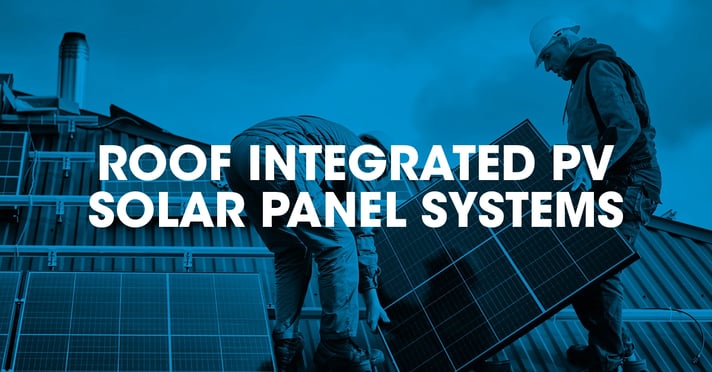Ventilation and condensation
We consider roof integrated PV solar panel systems to be an air impermeable roof covering. For the purposes of Warranty, our Technical Manual provides comprehensive guidance on ventilation strategies when using an air impermeable roof coverings.
Where a roof integrated PV panel system is installed as a part of the roof covering, even where the surrounding roof covering is classed as air permeable, the entire roof should be considered as impermeable.
Where the manufacturer can demonstrate their roof integrated PV panel system is sufficiently air open using the methods outlined in BS5250, an alternative ventilation strategy may be presented to the Warranty provider for consideration.
Other considerations
- Roof integrated PV solar panel system manufacturers may require a larger ventilated air space to their underside to increase ventilation and cooling of the panel.
- Where a LR underlay is specified, the manufacturer of the roof integrated PV panel system must confirm the underside of their system has a sufficient coating or protection to prevent corrosion.
Fixings, loadings and wind uplift calculations
Roof integrated PV solar panel systems and any associated flashing kits must be fixed in accordance with the manufacturer’s requirements using their specified proprietary fixings.
The fixing of the system must be suitably designed by an Engineer, be site specific for the geographical location and capable of resisting the dead loads, snow loads, wind loads and imposed loads applicable to the roof and its location. Wind loads vary considerably across the UK and are influenced by factors such as site altitude, building height and local topography.
Roof integrated PV solar system manufacturers should provide test data for the resistance of wind uplift. The test method should follow the principles of BSEN 14437, or alternatively following the guidance in the MCS Solar mounting standard MCS 012.
Where a roof integrated PV solar panel system manufacturer requires a larger ventilated air space to the underside of the inset PV panel, any increase to counter batten depths to accommodate larger ventilated voids must be fully factored into the wind uplift calculations for the system installation. Fixings securing the counter battens through to the rafters must be of sufficient strength and length and correctly spaced so as to resist dead loads, wind loads and imposed loads.
Any associated wind uplift calculations conducted by the manufacturer of the primary roof covering must include the interfaces with the roof integrated PV solar system, and any provision for additional fixings for the primary roof covering at its junctions around the roof integrated PV system.
All tiles and slates around the PV system should be treated as a perimeter tile/slate and be fixed in accordance with the site specific fixing methodology.
Durability
Roof integrated PV solar panel systems and all associated ancillary components, including flashing kits and fixings must be able to maintain their durability as a roof covering for at least 25 years.
Roof membranes used below the primary roof covering must not have their function or service life reduced or affected by the presence of the PV panel in service.
The Designer must provide evidence that the roof integrated PV solar panel system and associated flashing kits is suitable and compatible for use with the primary roof covering products. It may be that a roof covering manufacturer has certain products that are not suitable for use in conjunction with PV systems (integrated or above roof mounted).
All components must be confirmed as suitable for their geographical location in relation to durability.
Where used in coastal locations: Additional provisions will be required due to the aggressive environmental conditions that components will be exposed to. The designer must demonstrate all components used are suitable for such an environment and still achieve a 25 year service life. Please see Appendix B of the Technical Manual for further guidance.
Weather resistance
Roof integrated PV solar panel systems must not reduce the weather performance of the roof design and must not jeopardise the function of the roof underlay / membrane.
The proposed system must demonstrate a comparable performance to the primary roof covering and be provided with detailing that does not allow rainwater to enter the building fabric via structural connections, cabling or pipework penetrations.
Where the roof has a pitch exceeding 10 degrees: The roof integrated PV solar panel system manufacturer must provide test data based on PD CEN/TR 15601:2012 to determine the wind driven rain performance of the system. Alternatively they should provide weather tightness performance specific to integrated systems by following the guidance in the MCS Solar mounting standard MCS 012.
Ventilation paths provided by counter battens to avoid the detrimental effects of condensation within the batten space should not be impeded in their function by the completed installation of the inset PV panels, flashing kits or associated cabling.
All detailing must be strictly in accordance with manufacturer’s guidance and be fully resolved before any installation work is commenced. It must be fully weather tight and should not solely rely on the use of sealants.
Fire performance
The designer of the roof which incorporates a roof integrated PV solar panel systems must ensure the system is suitably tested and provides evidence that the proposal satisfies the relevant Building Control body in relation to compliance with Building Regulations.

